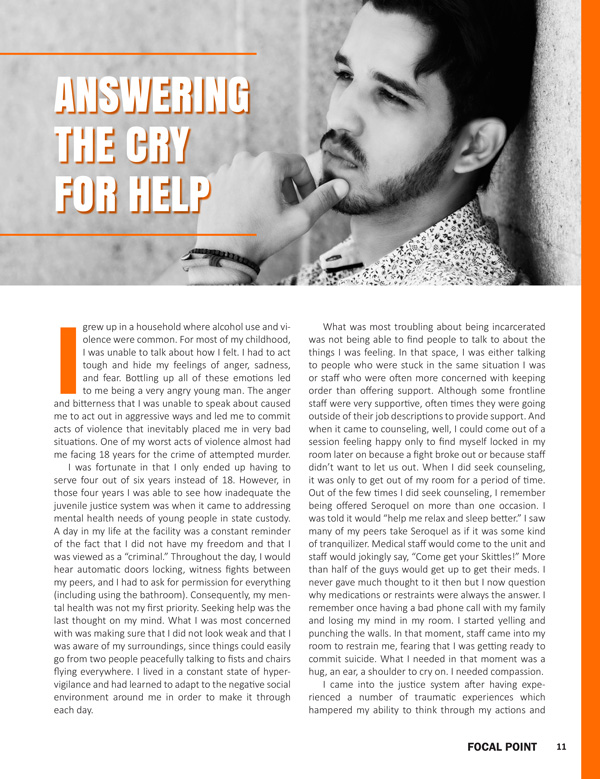
Abstract: A young adult provides a critique of the juvenile system in which he was incarcerated, noting its emphasis on treating mental health conditions with medication rather than therapy.
"Answering the Cry for Help" (2017)
By Hernan Carvente
I grew up in a household where alcohol use and violence were common. For most of my childhood, I was unable to talk about how I felt. I had to act tough and hide my feelings of anger, sadness, and fear. Bottling up all of these emotions led to me being a very angry young man. The anger and bitterness that I was unable to speak about caused me to act out in aggressive ways and led me to commit acts of violence that inevitably placed me in very bad situations. One of my worst acts of violence almost had me facing 18 years for the crime of attempted murder.
I was fortunate in that I only ended up having to serve four out of six years instead of 18. However, in those four years I was able to see how inadequate the juvenile justice system was when it came to addressing mental health needs of young people in state custody. A day in my life at the facility was a constant reminder of the fact that I did not have my freedom and that I was viewed as a “criminal.” Throughout the day, I would hear automatic doors locking, witness fights between my peers, and I had to ask for permission for everything (including using the bathroom). Consequently, my mental health was not my first priority. Seeking help was the last thought on my mind. What I was most concerned with was making sure that I did not look weak and that I was aware of my surroundings, since things could easily go from two people peacefully talking to fists and chairs flying everywhere. I lived in a constant state of hyper-vigilance and had learned to adapt to the negative social environment around me in order to make it through each day.
What was most troubling about being incarcerated was not being able to find people to talk to about the things I was feeling. In that space, I was either talking to people who were stuck in the same situation I was or staff who were often more concerned with keeping order than offering support. Although some frontline staff were very supportive, often times they were going outside of their job descriptions to provide support. And when it came to counseling, well, I could come out of a session feeling happy only to find myself locked in my room later on because a fight broke out or because staff didn't want to let us out. When I did seek counseling, it was only to get out of my room for a period of time. Out of the few times I did seek counseling, I remember being offered Seroquel on more than one occasion. I was told it would “help me relax and sleep better.” I saw many of my peers take Seroquel as if it was some kind of tranquilizer. Medical staff would come to the unit and staff would jokingly say, “Come get your Skittles!” More than half of the guys would get up to get their meds. I never gave much thought to it then but I now question why medications or restraints were always the answer. I remember once having a bad phone call with my family and losing my mind in my room. I started yelling and punching the walls. In that moment, staff came into my room to restrain me, fearing that I was getting ready to commit suicide. What I needed in that moment was a hug, an ear, a shoulder to cry on. I needed compassion.
I came into the justice system after having experienced a number of traumatic experiences which hampered my ability to think through my actions and regulate my emotions. What I came to realize while incarcerated was that the environment was not going to change – it was going to remain violent and unsafe, because that is what the culture and structure of the facility promoted. I needed to keep busy and find positive outlets to release what I was feeling and internalizing. Unfortunately, the opportunities for outlets and safe spaces were limited and I was often left to my own devices. For some of my peers, being in this space only caused them to act out more because they were constantly being viewed as having “behavioral” issues rather than as young men in need of support.
I want to convey to the reader that young adults do not always need psychotropic medication to address their mental health needs. When young people act out it does not mean that they are mentally unstable; it may just be a cry for help. Also, mental health and juvenile justice professionals must bear in mind that each system thinks about, and deals with, behavioral issues in different ways. Not all staff know how to deal with and address trauma, so proper training on how to respond is important when it comes to the mental health of young people in the justice system. A cry for help should not always be met with medication. A cry for help should not be met with physical restraints. A cry for help should be met with dialogue, compassion, and love – no matter how difficult a young adult's behavior may seem.
Suggested Citation
Carvente, H. (2017). Answering the Cry for Help. Focal Point: Youth, Young Adults, and Mental Health, 31, 11-12. Portland, OR: Research and Training Center for Pathways to Positive Futures, Portland State University.